Does anyone know how to use a scope for setting the tonearm for your turntable?
I have a new Pro-ject essentials lll table and it only has the little weight and fishing line for the anti-skate. I’d like to check it with my scope to see just how well it works. My older tables do a much better job with this as they use a dial for this.
So any help with how I can use a scope to see just how far off or not it is would be great. I have one of those set-up LP’s from Shure and it works pretty well and it tells me that it’s not set correctly and with the way Pro-Ject has this setup is not a very good system
Thanks
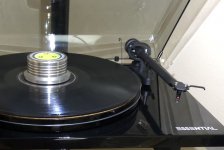
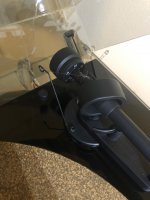
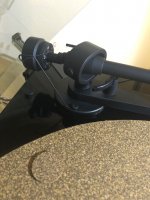
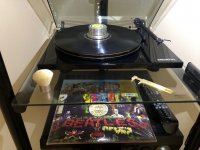
I have a new Pro-ject essentials lll table and it only has the little weight and fishing line for the anti-skate. I’d like to check it with my scope to see just how well it works. My older tables do a much better job with this as they use a dial for this.
So any help with how I can use a scope to see just how far off or not it is would be great. I have one of those set-up LP’s from Shure and it works pretty well and it tells me that it’s not set correctly and with the way Pro-Ject has this setup is not a very good system
Thanks




Now I wonder where they got that idea from SME ? --fishing line and weight on end --??--patent must have run out.
TTR-105 test record for scope ?
Have a read of-
Oscilloscope usage for cartridge alignment- Vinyl Engine
If you know your square waves its much easier to see discrepancies.
TTR-105 test record for scope ?
Have a read of-
Oscilloscope usage for cartridge alignment- Vinyl Engine
If you know your square waves its much easier to see discrepancies.
Thread and weight was never patented
The thread and weight bias compensation (aka anti-skate) system was devised by John Crabbe of Hi Fi News and published there. It couldn't have been patented by any commercial entity as 'prior art' existed. Crabbe never made any attempt to patent his idea before publishing details.
BTW, I had an early 70s Audio Technica AT-1005 Mk II that used the same system.
The thread and weight bias compensation (aka anti-skate) system was devised by John Crabbe of Hi Fi News and published there. It couldn't have been patented by any commercial entity as 'prior art' existed. Crabbe never made any attempt to patent his idea before publishing details.
BTW, I had an early 70s Audio Technica AT-1005 Mk II that used the same system.
Last edited:
Thanks for the information Mark I did not know this ,it must have been an early edition of Hi-Fi news as I owned two SME tonearms in the ,60,s complete with Quad 303 .
Is this the same well known J.Crabb of Practical Wireless + other UK 50,s electronic magazines ?
Is this the same well known J.Crabb of Practical Wireless + other UK 50,s electronic magazines ?
John Crabbe was the editor of Hi Fi News for many years, and continued to contribute articles on hi fi for a long time after he retired - he had a passion for horn-loaded speakers, and built a pair into his house!
Your question led me to look this up, and I find that it was in Wireless World that he published the thread-and-weight article, in May 1960. Sorry for the error! The article was entitled "Dynamic Sidethrust in Pickups", and as you rightly say the technique was then adopted by SME and others (I currently run an Origin Live arm, which uses it).
Thanks for helping me to enlighten myself! Plenty more info on John Crabbe at John Crabbe: Firebrand | Stereophile.com
Your question led me to look this up, and I find that it was in Wireless World that he published the thread-and-weight article, in May 1960. Sorry for the error! The article was entitled "Dynamic Sidethrust in Pickups", and as you rightly say the technique was then adopted by SME and others (I currently run an Origin Live arm, which uses it).
Thanks for helping me to enlighten myself! Plenty more info on John Crabbe at John Crabbe: Firebrand | Stereophile.com
Last edited:
Otherwise using an oscilloscope for cartridge alignment is a good idea. Most oscilloscopes can do Ch1 plus inverted Ch2 display which is good for testing channel balance and stylus azimuth.
There is (in my opinion) no perfect anti-skate system on tangential arm turntables.
The angle error will always be there.
If there is, I would like to know, whatever it is, since I have been using turntables for 50 years.
Put on your LP an RX plate cut out in the shape of it, adjust with the method you want, (wire and weight, magnetic force, adjustable spring, etc.), and adjust the anti-skate at a point that is approximately the middle of the LP.
Perfect? , the arm/needle does not move and remains static? Now take it to the beginning and end of the hypothetical LP, and you will see how it is no longer the same. It will be little for the beginning of the LP and much for the end.
But using an oscilloscope will always be fun, especially in these times.
The angle error will always be there.
If there is, I would like to know, whatever it is, since I have been using turntables for 50 years.
Put on your LP an RX plate cut out in the shape of it, adjust with the method you want, (wire and weight, magnetic force, adjustable spring, etc.), and adjust the anti-skate at a point that is approximately the middle of the LP.
Perfect? , the arm/needle does not move and remains static? Now take it to the beginning and end of the hypothetical LP, and you will see how it is no longer the same. It will be little for the beginning of the LP and much for the end.
But using an oscilloscope will always be fun, especially in these times.
BTW, I had an early 70s Audio Technica AT-1005 Mk II that used the same system.
Well, my Lenco L75 had it also in 1967 ...😉
https://www.lencoheaven.net/forum/index.php?topic=13.0
I'm sure the actual numbers will depend on stylus shape, tracking weight and alignment, but shouldn't antiskate follow tracing angle error somewhat as well, ie its a composite of error angle overlaid onto a diminishing amount as it tracks inwards?
You could measure it at multiple points and then use the falling weight modified by acting over a cam shaped wheel
You could measure it at multiple points and then use the falling weight modified by acting over a cam shaped wheel
Skating forces with a pivoted arm do change across a record, yes.
With those string/weight gadgets, it can only be somewhat accurate, depending on the geometry of the way the string is adapted.
Asides from that, actual skating varies depending on groove modulation too - loud parts of music tend to create more drag/skating.
Stylus shape is yet another variable in the mix.
So now you've got a bucketful of variables, changing as the music plays and the groove diameter changes.
So nothing's perfect, you can only reach a "somewhat happy" medium at best.
To eliminate all that fussing, I chose a linear-tracking turntable.
No more need to "wonder" if anything's "off".
Besides, that's the way records were cut anyway.
With those string/weight gadgets, it can only be somewhat accurate, depending on the geometry of the way the string is adapted.
Asides from that, actual skating varies depending on groove modulation too - loud parts of music tend to create more drag/skating.
Stylus shape is yet another variable in the mix.
So now you've got a bucketful of variables, changing as the music plays and the groove diameter changes.
So nothing's perfect, you can only reach a "somewhat happy" medium at best.
To eliminate all that fussing, I chose a linear-tracking turntable.
No more need to "wonder" if anything's "off".
Besides, that's the way records were cut anyway.
Skating forces with a pivoted arm do change across a record, yes.
With those string/weight gadgets, it can only be somewhat accurate, depending on the geometry of the way the string is adapted.
Asides from that, actual skating varies depending on groove modulation too - loud parts of music tend to create more drag/skating.
Stylus shape is yet another variable in the mix.
So now you've got a bucketful of variables, changing as the music plays and the groove diameter changes.
So nothing's perfect, you can only reach a "somewhat happy" medium at best.
To eliminate all that fussing, I chose a linear-tracking turntable.
No more need to "wonder" if anything's "off".
Besides, that's the way records were cut anyway.
Well I would trade my new with box Pro-Ject essentials III . Black color , For a very nice linear-tracking turntable. My table only has the rca outputs, no usb or preamp built into it
I’ve had a few over the years and away s liked them. Only other tables I like over the linear is the older denon tables.
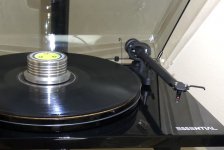
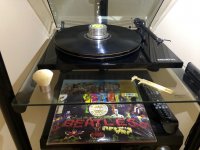
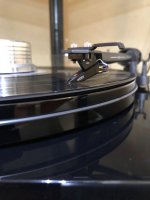
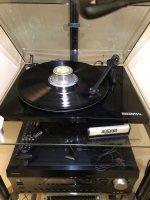
- Home
- Source & Line
- Analogue Source
- Using a Scope to setup your turntable